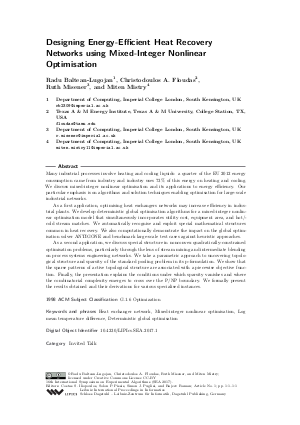Designing Energy-Efficient Heat Recovery Networks using Mixed-Integer Nonlinear Optimisation
Authors Radu Baltean-Lugojan, Christodoulos A. Floudas, Ruth Misener, Miten Mistry
-
Part of:
Volume:
16th International Symposium on Experimental Algorithms (SEA 2017)
Part of: Series: Leibniz International Proceedings in Informatics (LIPIcs)
Part of: Conference: International Symposium on Experimental Algorithms (SEA) - License:
 Creative Commons Attribution 3.0 Unported license
Creative Commons Attribution 3.0 Unported license
- Publication Date: 2017-08-07
File

PDF
LIPIcs.SEA.2017.1.pdf
- Filesize: 228 kB
- 1 pages
Document Identifiers
Subject Classification
Keywords
- Heat exchanger network
- Mixed-integer nonlinear optimisation
- Log mean temperature difference
- Deterministic global optimisation
Metrics
- Access Statistics
-
Total Accesses (updated on a weekly basis)
0PDF Downloads0Metadata Views
Abstract
Many industrial processes involve heating and cooling liquids: a quarter of the EU 2012 energy consumption came from industry and industry uses 73% of this energy on heating and cooling. We discuss mixed-integer nonlinear optimisation and its applications to energy efficiency. Our particular emphasis is on algorithms and solution techniques enabling optimisation for large-scale industrial networks. As a first application, optimising heat exchangers networks may increase efficiency in industrial plants. We develop deterministic global optimisation algorithms for a mixed-integer nonlinear optimisation model that simultaneously incorporates utility cost, equipment area, and hot/cold stream matches. We automatically recognise and exploit special mathematical structures common in heat recovery. We also computationally demonstrate the impact on the global optimisation solver ANTIGONE and benchmark large-scale test cases against heuristic approaches. As a second application, we discuss special structure in nonconvex quadratically-constrained optimisation problems, particularly through the lens of stream mixing and intermediate blending on process systems engineering networks. We take a parametric approach to uncovering topological structure and sparsity of the standard pooling problem in its p-formulation. We show that the sparse patterns of active topological structure are associated with a piecewise objective function. Finally, the presentation explains the conditions under which sparsity vanishes and where the combinatorial complexity emerges to cross over the P/NP boundary. We formally present the results obtained and their derivations for various specialised instances.
Cite As Get BibTex
Radu Baltean-Lugojan, Christodoulos A. Floudas, Ruth Misener, and Miten Mistry. Designing Energy-Efficient Heat Recovery Networks using Mixed-Integer Nonlinear Optimisation. In 16th International Symposium on Experimental Algorithms (SEA 2017). Leibniz International Proceedings in Informatics (LIPIcs), Volume 75, p. 1:1, Schloss Dagstuhl – Leibniz-Zentrum für Informatik (2017)
https://doi.org/10.4230/LIPIcs.SEA.2017.1
BibTex
@InProceedings{balteanlugojan_et_al:LIPIcs.SEA.2017.1,
author = {Baltean-Lugojan, Radu and Floudas, Christodoulos A. and Misener, Ruth and Mistry, Miten},
title = {{Designing Energy-Efficient Heat Recovery Networks using Mixed-Integer Nonlinear Optimisation}},
booktitle = {16th International Symposium on Experimental Algorithms (SEA 2017)},
pages = {1:1--1:1},
series = {Leibniz International Proceedings in Informatics (LIPIcs)},
ISBN = {978-3-95977-036-1},
ISSN = {1868-8969},
year = {2017},
volume = {75},
editor = {Iliopoulos, Costas S. and Pissis, Solon P. and Puglisi, Simon J. and Raman, Rajeev},
publisher = {Schloss Dagstuhl -- Leibniz-Zentrum f{\"u}r Informatik},
address = {Dagstuhl, Germany},
URL = {https://drops.dagstuhl.de/entities/document/10.4230/LIPIcs.SEA.2017.1},
URN = {urn:nbn:de:0030-drops-76288},
doi = {10.4230/LIPIcs.SEA.2017.1},
annote = {Keywords: Heat exchanger network, Mixed-integer nonlinear optimisation, Log mean temperature difference, Deterministic global optimisation}
}
